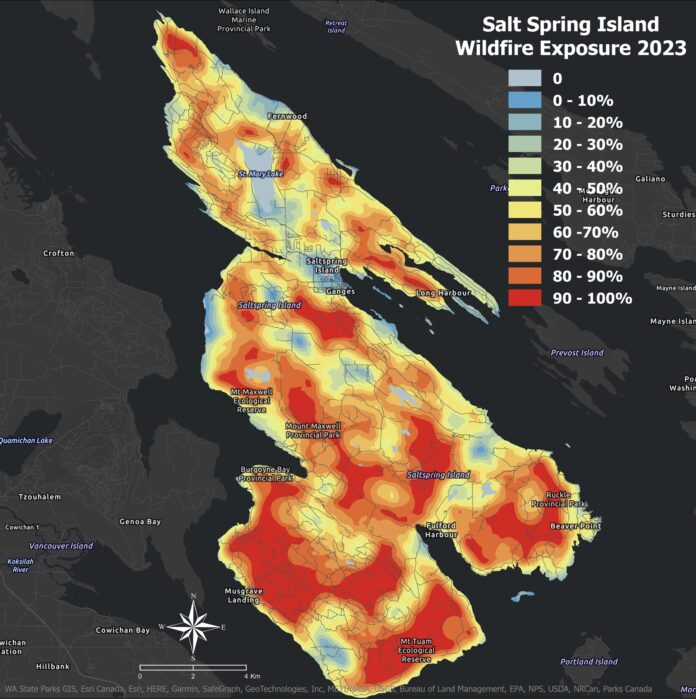Two agencies tasked with emergency management and response approached Salt Spring’s Local Trust Committee (LTC) last week to ask for special requirements and guidelines for developers looking to build in areas on the island at higher risk for fire.
“I don’t pretend to be a governance expert,” chuckled Salt Spring Island Fire Rescue (SSIFR) Chief Jamie Holmes, who addressed trustees at their regular meeting Thursday, Sept. 14. But, he said, the district was again recommending the LTC add a wildfire hazard development permit area (DPA) within Salt Spring Island’s official community plan (OCP).
Holmes said SSIFR was hoping for a governing document with a multi-pronged approach, beginning with an educational portion — on creating defensible spaces between wildland and parks, buildings and houses — and a prescriptive portion, dealing with ensuring adequate water supplies to fight fires at and around new development.
“We make recommendations that developers can ignore,” said Holmes. “We have no way of enforcement on that. Unfortunately, we see major subdivisions being put in that don’t have any water supply capabilities [for firefighting] that are backing on major forest interfaces; if anything happened on either side, the transition between the two worlds would happen quickly. And we’d have very little way of stopping that.”
The third prong would be restrictive measures, Holmes said, surrounding building materials used in the first place that might be more susceptible to spreading wildfire — such as cedar shake roofing.
“Buildings tend to burn from the top down,” said Holmes. “And so if we can look at materials that help us, that goes a long way.”
Holmes emphasized the importance of defensible spaces in particular for firefighter efficacy — and safety.
“If we don’t have those areas we can defend, if we don’t have acres we can work off of, honestly, we put our members at risk,” said Holmes. “So we need to have spaces to ‘anchor’ attacks off of, that provide us with the safety and ability to work.”
Jonathan Reimer, Fire and Emergency Programs manager for the Capital Regional District (CRD), shared Holmes’ concerns.
“Obviously in the recent weeks and months, we’ve all been paying close attention to the wildfire disasters that we’ve seen in Maui, West Kelowna, Lytton and other places,” said Reimer. “And wildfire resilience is something that’s, I think, close to the heart of most of our residents — and it’s something that is a shared responsibility between the Islands Trust as land manager, CRD as local government, and a series of improvement districts and societies.”
The good news, according to Reimer, is that the recently completed Community Wildfire Resiliency Plan for Salt Spring Island — which examined ecology, fuel systems and fire history for the island and produced a wildfire risk map, along with recommendations for how to improve things — found that wildfire risk across Salt Spring can broadly be described as “moderate.”
“And moderate wildfire risk means that the fires that have the highest intensity, like what we saw on Maui and in West Kelowna, are quite unlikely here,” said Reimer.
That does not mean, he added, that we should underestimate the potential impact of “moderate” intensity fire — including the loss of structures and the displacement of people for an extended amount of time. And, Reimer said, recent mapping showed most of the wildfire risk on Salt Spring stemmed from private land; the joint project between the Islands Trust and CRD created a “wildfire exposure” map that looked at the distribution of risk geographically, and across all land ownership classes.
“I think we probably need to start working together at a higher level than we have in the past,” said Reimer. “I know the issue of fragmented governance is something that is a continual challenge for our island communities, [but] an effective wildfire response will require all of us to work together in novel ways.”
That would include, he said, partnering to implement the plan’s recommendations — including the creation of a wildfire-specific DPA, as Holmes and SSIFR had requested, as well as a development approval information provision, development application materials and designating wildfire hazard areas in the next OCP update. Importantly, funding for much of that work could be obtained through provincial programs, not unlike those that fund FireSmart efforts already.
“Some of the activities that we would like to see done could be done by the Islands Trust,” said Reimer, “and we could pursue the funding through our [CRD] side and have an arrangement to provide you with some of the resources to complete the work.”

